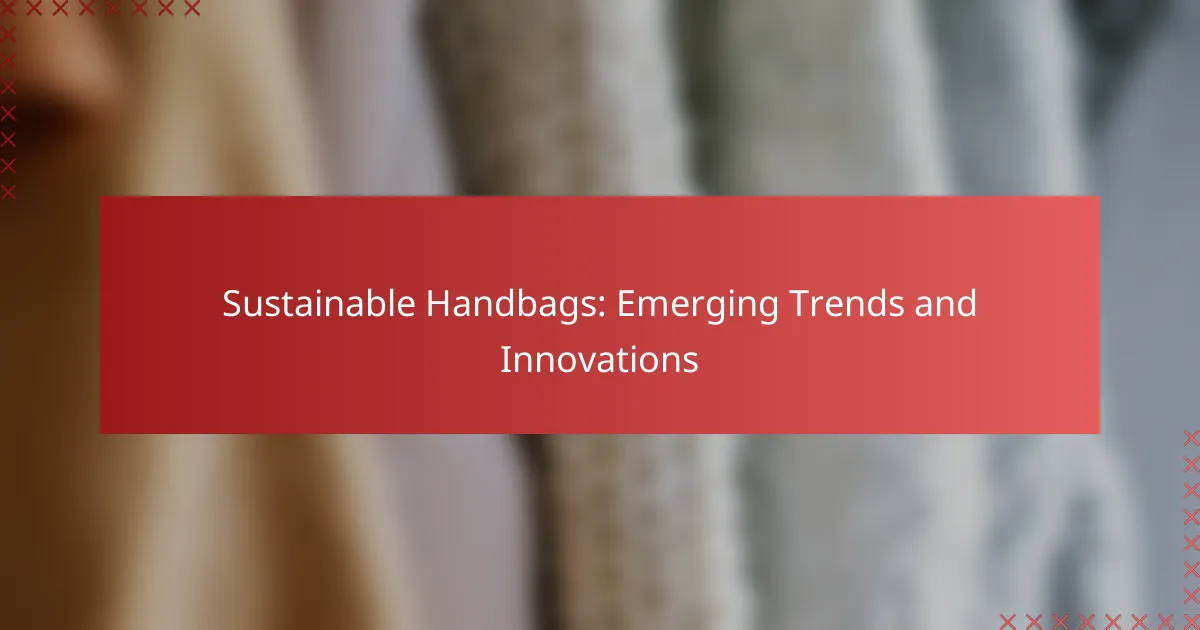The sustainable handbag market is rapidly evolving, with a strong emphasis on eco-friendly materials and ethical production practices. As consumers become more environmentally conscious, brands are innovating to create stylish, durable products that support local artisans and reduce environmental impact.

What are the latest trends in sustainable handbags?
The latest trends in sustainable handbags focus on eco-friendly materials, innovative designs, and ethical production practices. Consumers increasingly seek products that minimize environmental impact while supporting local artisans and communities.
Eco-friendly materials
Eco-friendly materials are at the forefront of sustainable handbag trends. Brands are using organic cotton, hemp, and recycled plastics to create stylish yet environmentally conscious products. These materials often have a lower carbon footprint and can be sourced sustainably.
Additionally, innovative alternatives like mushroom leather and pineapple fibers are gaining popularity. These materials not only reduce reliance on traditional leather but also promote biodiversity and sustainable farming practices.
Upcycled fashion
Upcycled fashion involves repurposing discarded materials into new products, which is a growing trend in sustainable handbags. Designers are creatively transforming old garments and fabrics into unique handbags, reducing waste and extending the lifecycle of materials.
This approach not only minimizes environmental impact but also offers consumers one-of-a-kind pieces. Brands often highlight their upcycling processes, appealing to eco-conscious shoppers looking for distinctive styles.
Minimalist designs
Minimalist designs are becoming increasingly popular in sustainable handbags, emphasizing simplicity and functionality. These designs often feature clean lines, neutral colors, and versatile shapes that can be used for various occasions.
By focusing on essential features and reducing excess, minimalist handbags encourage consumers to invest in quality over quantity. This trend aligns with the broader movement towards conscious consumption and decluttering lifestyles.
Smart technology integration
Smart technology integration is an emerging trend in sustainable handbags, combining fashion with functionality. Some brands are incorporating features like wireless charging pockets and anti-theft technology, enhancing user convenience while maintaining eco-friendly practices.
These innovations cater to tech-savvy consumers who value practicality without compromising on sustainability. As technology advances, more brands are likely to explore these integrations, making sustainable handbags even more appealing.
Local artisan collaborations
Collaborating with local artisans is a key trend in the sustainable handbag market. By partnering with skilled craftspeople, brands can create unique products that reflect cultural heritage and support local economies.
These collaborations often emphasize traditional techniques and materials, ensuring that the production process is ethical and sustainable. Consumers are increasingly drawn to these handbags, as they not only promote sustainability but also tell a story of craftsmanship and community support.
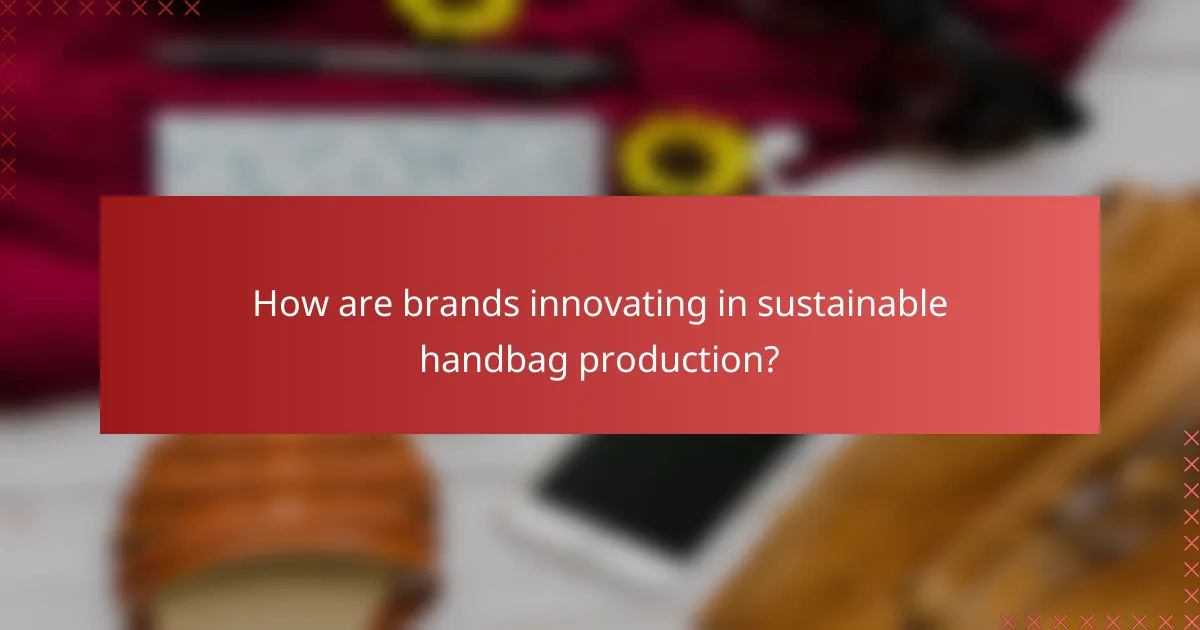
How are brands innovating in sustainable handbag production?
Brands are innovating in sustainable handbag production by incorporating eco-friendly materials and advanced technologies to reduce environmental impact. These innovations not only enhance the sustainability of the products but also appeal to environmentally conscious consumers.
Use of biodegradable materials
Many brands are now using biodegradable materials such as organic cotton, hemp, and plant-based leathers to create handbags. These materials break down naturally over time, minimizing landfill waste and reducing the carbon footprint associated with traditional leather production.
When selecting biodegradable materials, consider their sourcing and processing methods. Certifications like Global Organic Textile Standard (GOTS) can help ensure that the materials are produced sustainably. Brands often highlight these certifications to build consumer trust.
3D printing techniques
3D printing is revolutionizing handbag production by allowing for on-demand manufacturing, which reduces waste and excess inventory. This technology enables designers to create intricate patterns and structures that would be difficult to achieve with traditional methods.
Brands utilizing 3D printing can offer customization options, allowing consumers to personalize their handbags. However, it’s essential to consider the materials used in 3D printing, as some plastics may not be biodegradable. Look for brands that use recycled or bio-based filaments.
Waterless dyeing processes
Waterless dyeing processes, such as digital printing and air dye technology, significantly reduce water consumption in handbag production. Traditional dyeing methods can use thousands of liters of water, while these innovative techniques minimize water use and pollution.
Brands adopting waterless dyeing often report lower production costs and faster turnaround times. When choosing a sustainable handbag, check if the brand employs these technologies, as they contribute to a more eco-friendly lifecycle for the product.
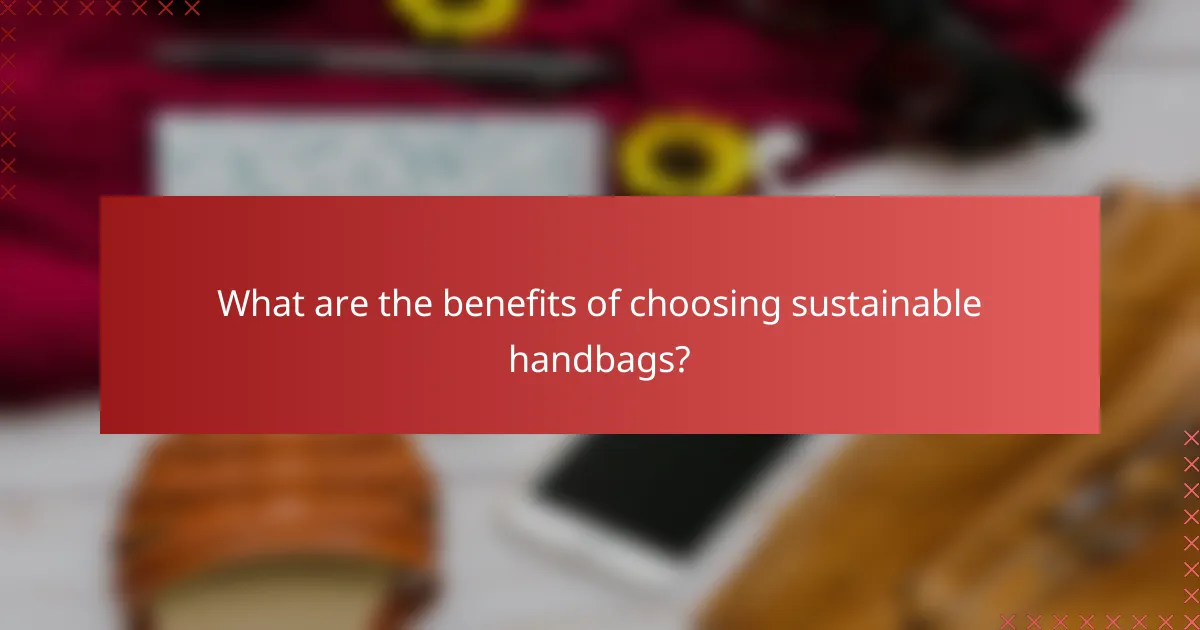
What are the benefits of choosing sustainable handbags?
Choosing sustainable handbags offers numerous advantages, including reduced environmental impact, support for ethical labor practices, and enhanced durability. These benefits not only contribute to a healthier planet but also promote fair working conditions and long-lasting products.
Environmental impact reduction
Sustainable handbags are designed to minimize environmental harm by using eco-friendly materials and production methods. For instance, bags made from organic cotton, recycled plastics, or vegan leather significantly lower carbon footprints compared to traditional leather or synthetic options.
Additionally, many brands implement sustainable practices such as water conservation and waste reduction during manufacturing. This commitment helps preserve natural resources and reduces pollution, making a positive contribution to the environment.
Support for ethical labor practices
By choosing sustainable handbags, consumers often support brands that prioritize fair labor practices. Many sustainable companies ensure that their workers receive fair wages, safe working conditions, and reasonable hours, which contrasts sharply with the often exploitative practices in fast fashion.
Moreover, some brands are transparent about their supply chains, allowing consumers to make informed choices. This transparency fosters accountability and encourages other companies to adopt similar ethical standards.
Durability and longevity
Sustainable handbags are typically crafted with high-quality materials that enhance their durability and lifespan. Unlike cheaper alternatives, these bags are designed to withstand daily use, making them a wise investment over time.
When selecting a sustainable handbag, look for features such as reinforced stitching and quality hardware. Investing in a durable bag not only reduces the need for frequent replacements but also contributes to less waste in landfills.
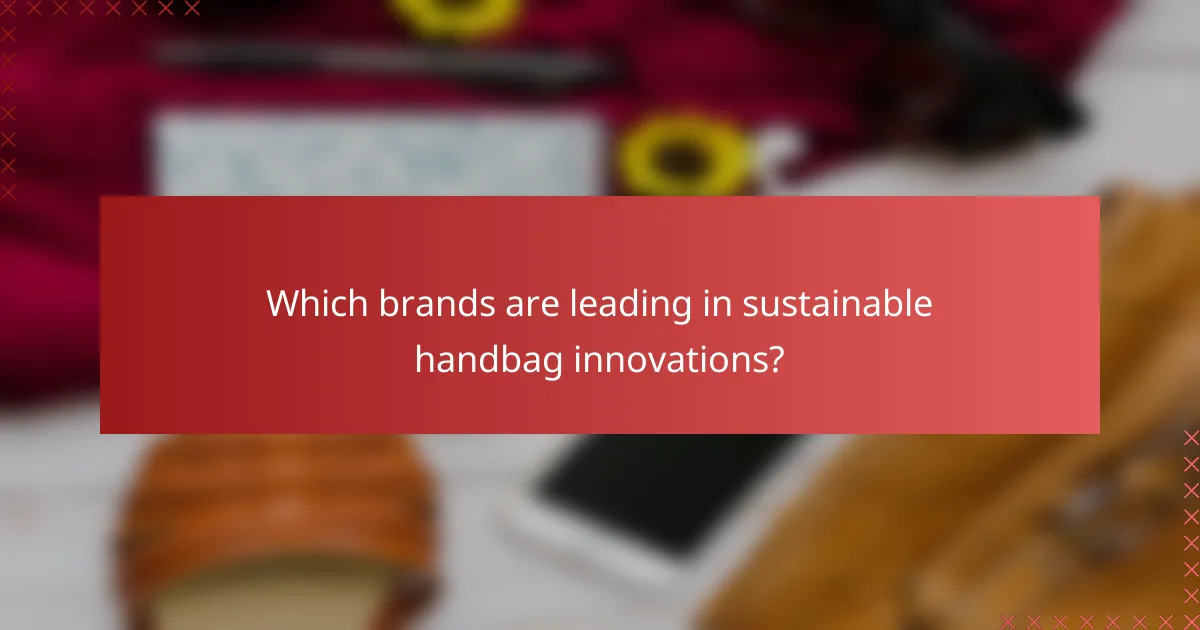
Which brands are leading in sustainable handbag innovations?
Several brands are at the forefront of sustainable handbag innovations, focusing on eco-friendly materials and ethical production practices. Notable leaders include Stella McCartney, Matt & Nat, and Reformation, each contributing uniquely to the sustainability movement in fashion.
Stella McCartney
Stella McCartney is renowned for her commitment to sustainability, using vegan leather and recycled materials in her handbag collections. The brand emphasizes transparency in its supply chain, ensuring that all materials are sourced responsibly.
One of the key innovations is the use of biodegradable materials and innovative textiles, such as ECONYL, which is made from recycled nylon. This approach not only reduces waste but also promotes circular fashion.
Matt & Nat
Matt & Nat stands out for its dedication to using recycled materials, including plastics and rubber, in its handbag designs. The brand’s ethos revolves around creating stylish products while minimizing environmental impact.
Every Matt & Nat handbag features linings made from 100% recycled plastic bottles, showcasing a practical approach to sustainability. Their commitment to ethical production is evident in their fair labor practices and eco-friendly manufacturing processes.
Reformation
Reformation integrates sustainability into every aspect of its handbag production, from sourcing materials to manufacturing. The brand focuses on using deadstock fabrics and recycled materials, significantly reducing waste in the fashion industry.
Reformation’s handbags are designed with a low environmental footprint, and the brand provides transparency about its impact through a detailed sustainability report. This allows consumers to make informed choices while supporting eco-conscious fashion.
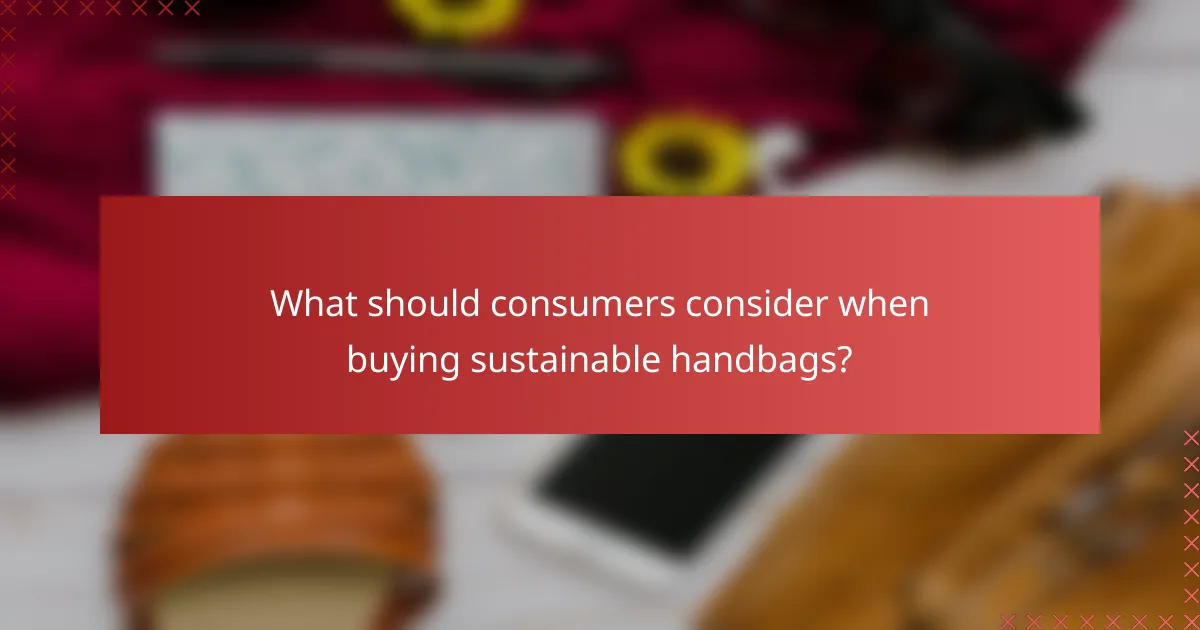
What should consumers consider when buying sustainable handbags?
Consumers should prioritize material sourcing, brand transparency, and lifecycle impact when selecting sustainable handbags. These factors significantly influence the environmental and ethical footprint of the products.
Material sourcing
Material sourcing is crucial in determining the sustainability of a handbag. Look for bags made from eco-friendly materials such as organic cotton, recycled plastics, or vegan leather alternatives. Avoid products made from conventional leather or synthetic materials that contribute to pollution.
Check for certifications like Global Organic Textile Standard (GOTS) or OEKO-TEX, which indicate responsible sourcing practices. Brands that disclose their supply chain practices tend to be more reliable in their sustainability claims.
Brand transparency
Brand transparency involves how openly a company shares information about its manufacturing processes and sourcing. Seek brands that provide clear details about their materials, labor practices, and environmental impact. Transparency fosters trust and allows consumers to make informed choices.
Look for brands that publish sustainability reports or engage in third-party audits. This information can help you assess whether a brand genuinely commits to sustainable practices or merely engages in greenwashing.
Lifecycle impact
Understanding the lifecycle impact of a handbag includes considering its production, use, and disposal phases. Evaluate how long the handbag is expected to last and whether it can be repaired or recycled at the end of its life. Durable products reduce waste and resource consumption over time.
Consider brands that offer take-back programs or recycling initiatives, which can help minimize landfill contributions. A handbag designed for longevity and recyclability is often a better investment in sustainability.
